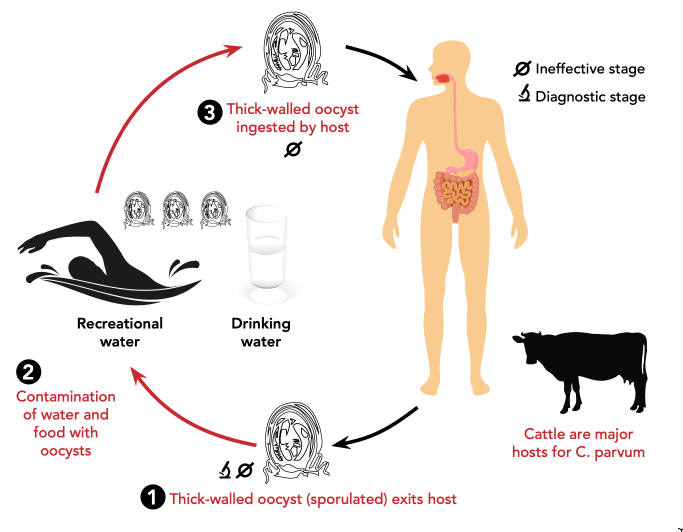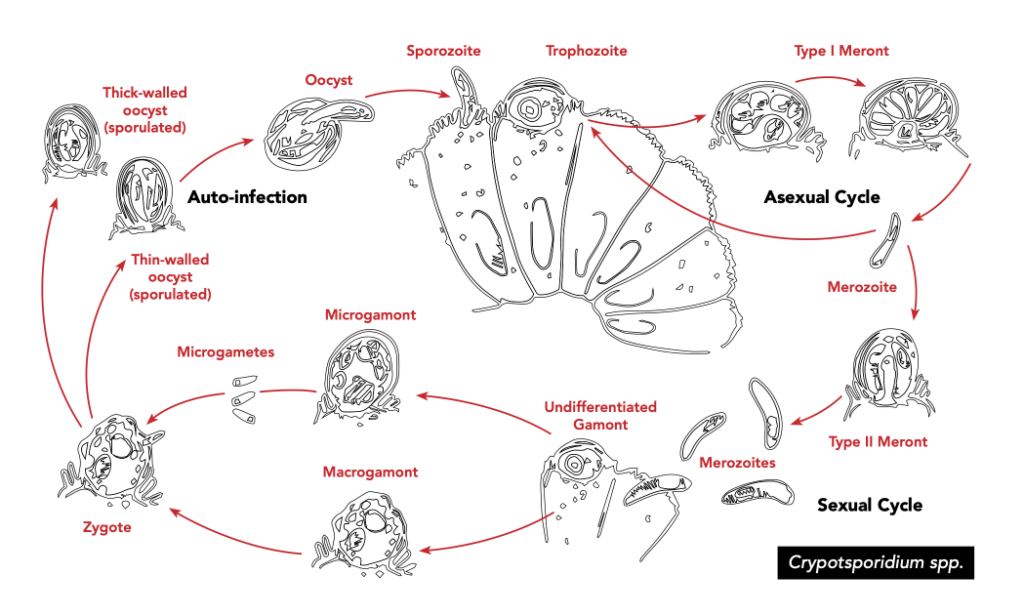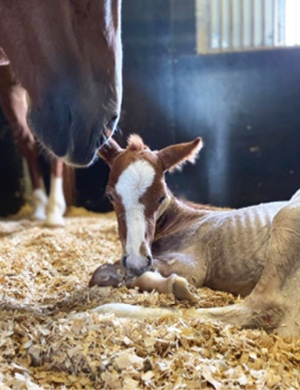There are many different zoonotic diseases to be mindful of when owning horses in Australia; some of the more commonly known ones include Hendra virus, ringworm, Psittacosis and Salmonella. Here we are going to look at cryptosporidiosis, an infectious disease that has been recognised in foals in the last decade.
What is a zoonotic disease?
A zoonotic disease is an infectious disease that is transmitted from animals to humans and, in some cases, from humans to animals. Such infectious diseases include viruses, bacteria, fungi and parasites. They may be spread in several different ways, including direct contact, indirect contact, vector-borne (such as tick, flea or mosquito), foodborne and waterborne.
Whilst we are looking at the specific disease cryptosporidiosis, it is a gentle reminder to animal owners to be aware of zoonotic diseases and to ensure that appropriate protective strategies are taken, particularly when handling their animals, but particularly when handling sick animals.
What is cryptosporidiosis?
Also known as crypto – cryptosporidiosis is a gastrointestinal infection caused by the protozoan parasite cryptosporidium species. It is a well-known cause of diarrhoea in humans and animals across the world. There are many different types – 19 species and 14 genotypes, with cryptosporidium parvum (C.parvum) being a more common cause of infection in animals and humans. It is particularly known of within the farming industry as it causes diarrhoea in calves, lambs, kids, piglets and deer.

What type of organism is it?
What type of disease does cryptosporidia cause?
They are highly contagious gastrointestinal parasites and cause weight loss and diarrhoea in the host it infects.
What is the lifecycle of cryptosporidia?
The lifecycle consists of several events. Oocysts play a key role; they are essentially eggs that are produced within the host by the parasite and are excreted in the faeces of the host. These oocysts are ingested via faecal contaminants, including water and feed. They then hatch inside the body. Cryptosporidia have quite an interesting lifecycle and can exist in several different forms. They initially multiply by asexual means but can then develop male (microgamont) and female (macrogamont) forms. The protozoa become embedded in the lining of the gastrointestinal system within the enterocytes of the villi, causing them to become atrophied.
There are actually two forms of oocysts – thick-walled, which are excreted, and thin- walled, which are involved in autoinfection (self-infection). The thick-walled oocysts are able to survive in the environment for protracted periods of time. Oocysts are resistant to many disinfectants and require careful selection to remove them from the environment and reduce their infectivity.

Cryptosporidiosis in the Horse
Horse cryptosporidiosis was first reported in immunodeficient Arab foals with diarrhoea and in immunodeficient adult horses. Since those first reports, it has been recognised as a cause of diarrhoea in foals. A review in 2015 suggested it occurs across the world within the domestic horse population – this included an outbreak on a TB stud in New Zealand.
Foals become infected by ingesting the parasite (in the oocyst stage) in contaminated food or water. As mentioned previously, crypto is common in ruminants, so there may be increased exposure of foals and horses in environments where there are cattle.
There are many causes of diarrhoea in the foal, ranging from “foal heat diarrhoea” nutritional causes, Salmonella, Clostridia, Rotavirus, Rhodoccus, Lawsonia, Strongyle worms, E. coli, Coronavirus and Cryptosporidia. Foals, like any newborn or young animal, are very prone to gastrointestinal upsets and infection.
Diarrohea in the foal can vary in severity and prognosis according to the cause – it can vary from a transitory change in the consistency of the faeces to life- threatening septicaemia and fluid loss. It is therefore very important that when owners are faced with a foal with diarrhoea that persists, or if the foal appears sick and off suck, to seek prompt veterinary attention rather than assume it is innocuous – foals can deteriorate very rapidly, with some of the causes being fatal.
Crypto as a cause of diarrhoea in the foal is more commonly seen in those aged 1- 4 weeks; however, it has also been reported in foals that are younger than a week and up to 6 months of age.
Crypto is less common in the adult horse as a primary infection unless the horse is immunocompromised. Some adult horses may be subclinical with evidence of the organism detected in faecal samples. It is sometimes identified in the faeces of older horses with other gastrointestinal infections.
It appears that crypto is commonly a coinfection and occurs with other infectious diseases. Although there is much research in human medicine with such, for example, Human Immunodeficiency Virus (HIV) favours opportunistic infections with other agents. Although in veterinary medicine, there is an understanding that gastrointestinal infections may be caused by several different organisms, there isn’t comprehensive published knowledge of the extent and possible combinations of the different infectious agents; there is also likely to be variation across the world.
What are the clinical signs of cryptosporidiosis?
The main clinical presenting signs are diarrhoea, weight loss and dehydration that persists for a few days. The faeces are pale or yellow and may contain mucus. The foals may become listless and dull; they often go off suck.
This may result in dehydration and weakness. The weight loss can be profound and occur very quickly.
How is cryptosporidiosis diagnosed?
The oocysts may be identified in the faeces via staining and immune fluorescence assays. The protozoa can be identified in the faeces by ELISA and PCR.
Here in Australia, faecal PCR tests are commonly performed when diagnosing gastrointestinal infections, and results are usually available within a couple of days.
How is cryptosporidiosis treated?
What is the prognosis?
Can humans catch cryptosporidia from horses?
As discussed previously, crypto is a zoonotic disease, so humans can become infected by other species, including foals. Immunocompromised people are more likely to be affected, but healthy people can succumb to the infection. It has been reported that in Italy, a group of veterinary students became infected when handling foals with crypto in a teaching hospital, and I had a client a few years ago that had a sick foal with crypto and he himself became infected when closely handling the foal without protection, prior to it arriving to the veterinary hospital. It is, therefore, imperative that horse owners are aware of the zoonotic potential when handling foals and horses with diarrhoea to prevent immunocompromised people from handling them and to practise good biosecurity principles.
In humans, ingestion of the parasite can cause watery diarrhoea, vomiting, stomach cramps and weight loss, with the symptoms lasting up to two weeks.
How can cryptosporidiosis be prevented?
Cryptosporidiosis can be challenging to prevent and control. There are no vaccines currently available for Cryptosporidiosis or specific treatment for infection in animals. Infected animals can cause a heavily contaminated environment by shedding large numbers of oocysts in their diarrhoea. Oocysts shed in faeces are very hardy and can survive for extended periods in the environment. It should be noted that they are also resistant to many disinfectants – those to be considered effective include hydrogen peroxide, ammonium hydroxide and chlorine dioxide.
Good biosecurity protocols, including isolation of infected foals and disinfection of contaminated areas and objects, are the best ways to prevent cryptosporidiosis.
Horse owners that also have cattle, goats, sheep and/or pigs should be mindful of the zoonotic potential between species, especially if they have other young animals with diarrhoea.
Summary
Crypto (cryptosporidiosis) is a protozoal parasite that causes gastrointestinal disease in humans and animals across the world – it is a recognised zoonotic disease. It infects the intestine, causing weight loss, diarrhoea and dehydration. Infection is caused by the ingestion of the oocysts, which can persist for months in the environment and are resistant to many disinfectants.
It is recognised as a cause of diarrhoea in the foal and occasionally in adults. It seems that it may coinfect with other gastrointestinal infections.
Horse owners need to be aware of this disease, particularly if their horses have contact with ruminants, where it is a common cause of diarrhoea in calves. This article also serves as a reminder to practise good personal hygiene and biosecurity measures when handling sick animals, as there are many known zoonotic diseases and many new emerging zoonoses.

